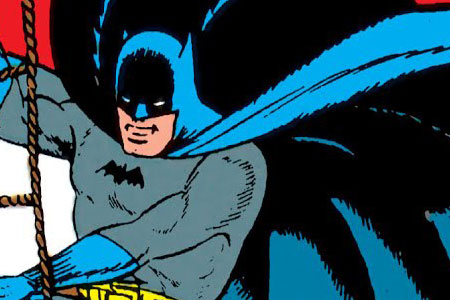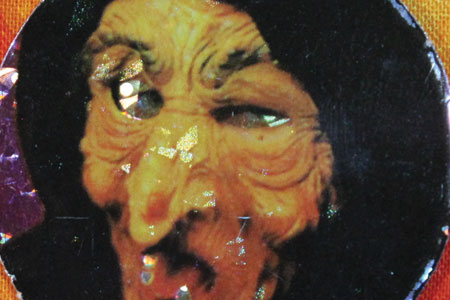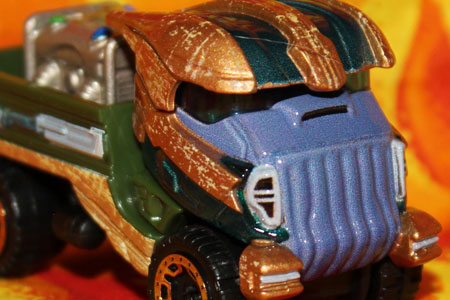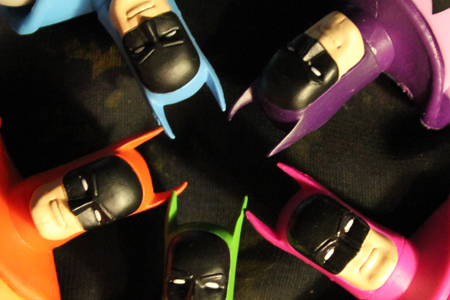
So far, Batman has made some terrible jokes, covered everything he owns in radioactive powders and inks, fought against a guy named Clubfoot, accidentally perpetuated slavery and killed a whole lot of people. The Batman of 1940 is a bit of a moral mess, but his weird little costumed heart is in the right place. By the time Batman #4 rolls around, is he less of a hot pile of crime-fighting trash?
No. And maybe he’s getting worse.
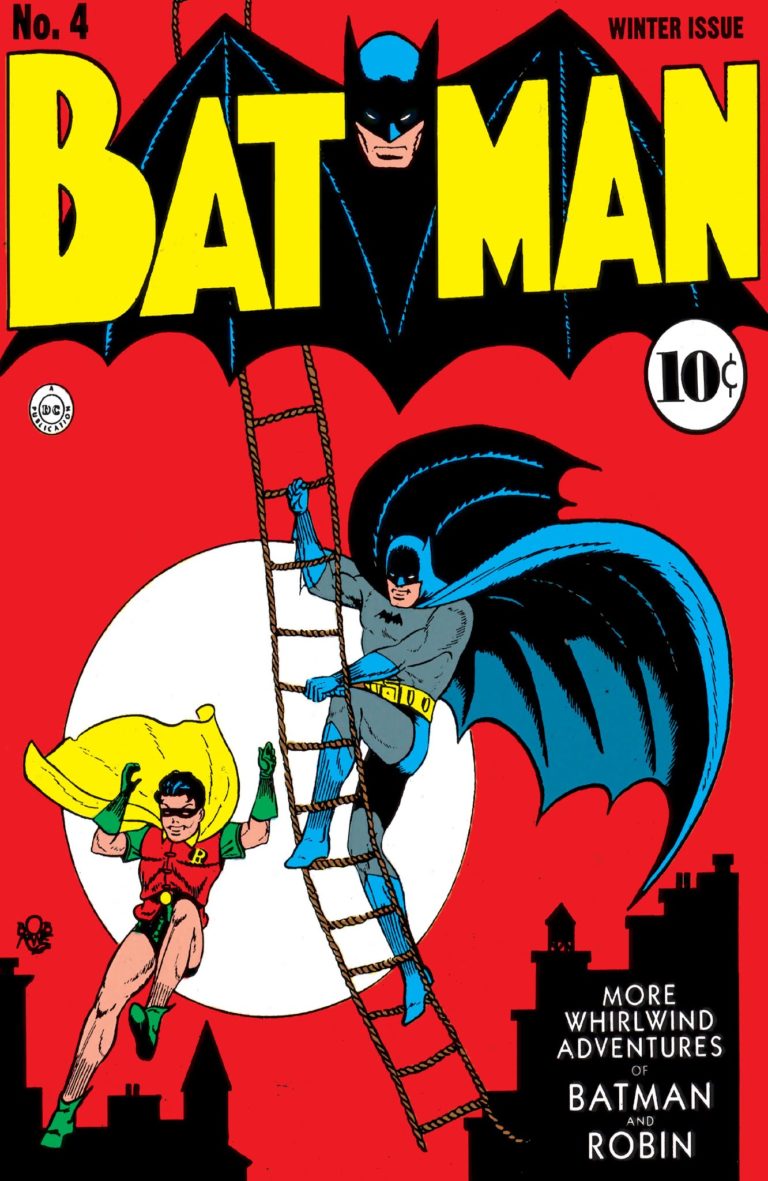
1940’s Batman #4 (the Winter Issue) starts with a Joker tale. The Clown Prince of Crime, “a ghastly, deliberate mockery, like life taunting death”, has survived last issue’s big fight, where he was knocked over a ship’s railing and into the depths of the ocean. He’s quickly rescued by a couple of well-meaning sailors who haven’t heard of The Joker before, despite him being portrayed as an internationally famous figure of pure terror only a couple of issues ago. Whatever, it was dark.
Two months later, Batman and Robin are skulking around in the dark when they end up tussling with a bunch of acrobatic, masked criminals who are robbing a mansion. They beat up the heroes pretty easily and run away.
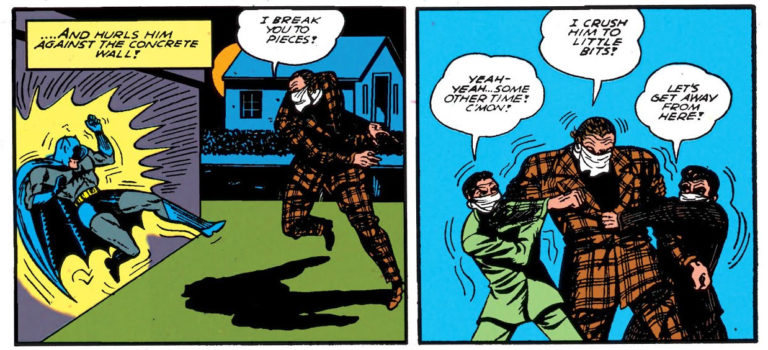
Another week passes; four more mansions are robbed while Batman does nothing, having decided that super-strong, unnaturally agile criminals are no big deal. Then, coincidentally, Bruce Wayne is invited to one of his fancy society parties at the home of CR Darcey, which is weird because everybody seems to straight-up HATE Bruce Wayne. They call him an empty-headed, lazy idiot almost every chance they get. But hey, they guy’s got money, so he’s automatically invited. This is not the Bruce Wayne who’s regarded as a powerful, shrewd businessman. Early Bruce played up his ‘goofy playboy’ alter-ego so well that he was pretty much reviled. Which, honestly, is a better disguise than today’s evasive Bruce Wayne.
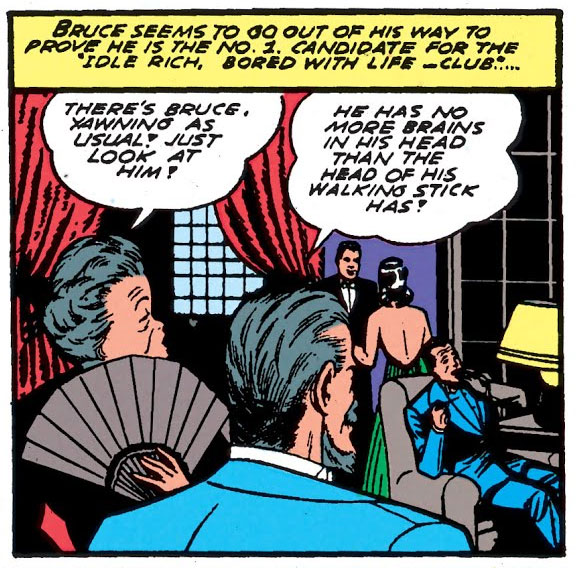
You know what happens next, because it happens every time.
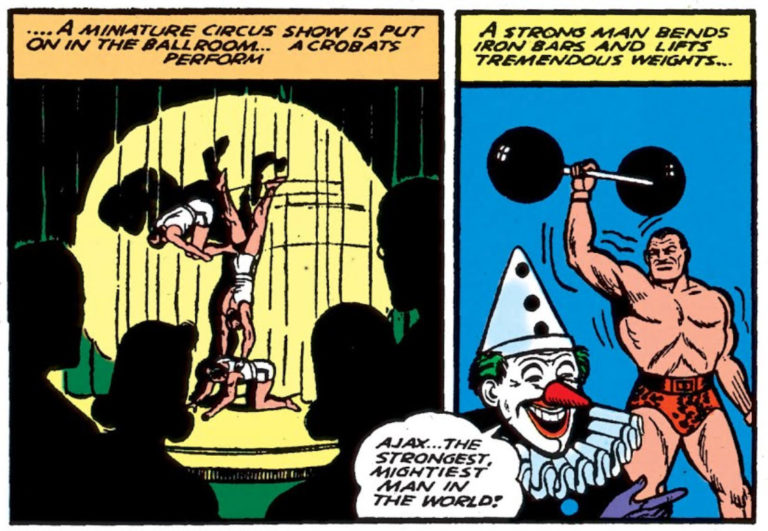
Rich people do rich people things and invite a miniature circus into their home… despite the fact that the last five mansions that invited in the parade of performers were robbed blind. Of course, Bruce doesn’t make this connection until it’s too late, even through the Clown Prince of Crime is literally disguised as a clown. This is also a really, really careful Joker who’s actively casing the joint before him and his thugs commit the crime, instead of just wildly rushing in, Joker-style. Fair enough; an out-of-character Joker is practically an in-character Joker, since he’s pretty unpredictable. Surprise, the mansion is later robbed.
The circus has an appointment with the Morganbilts, as announced in the newspaper, so Batman shows up and crashes through the window. Bear in mind that Batman knows that no crime is going to be committed tonight; Joker is only scouting the place out. The worst thing that’s going to happen is some rich jerks are going to get a great show. Batman could easily nab the whole crew on the way out, or follow them back to their haunted house hideout, avoiding the possibility of civilian casualties… but this Batman endangers more human lives than the Joker in this moment. What a goddamned dope.
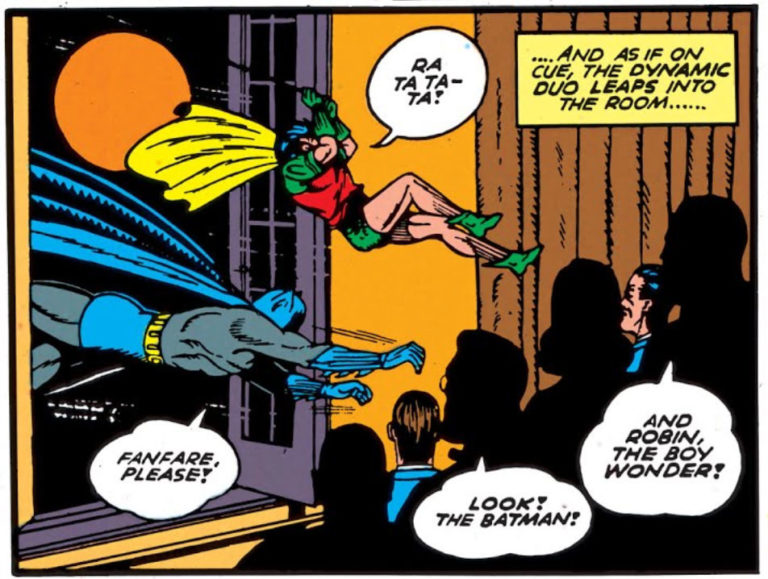
A fight ensues, and all of the performers are beaten half to death. After it’s all wrapped up, the Dynamic Duo finally follow the Joker back to his hideout, where the only real terror is how the panels are laid out. Batman is distracted by fighting a fake ghost, while Robin is kidnapped by the Joker.
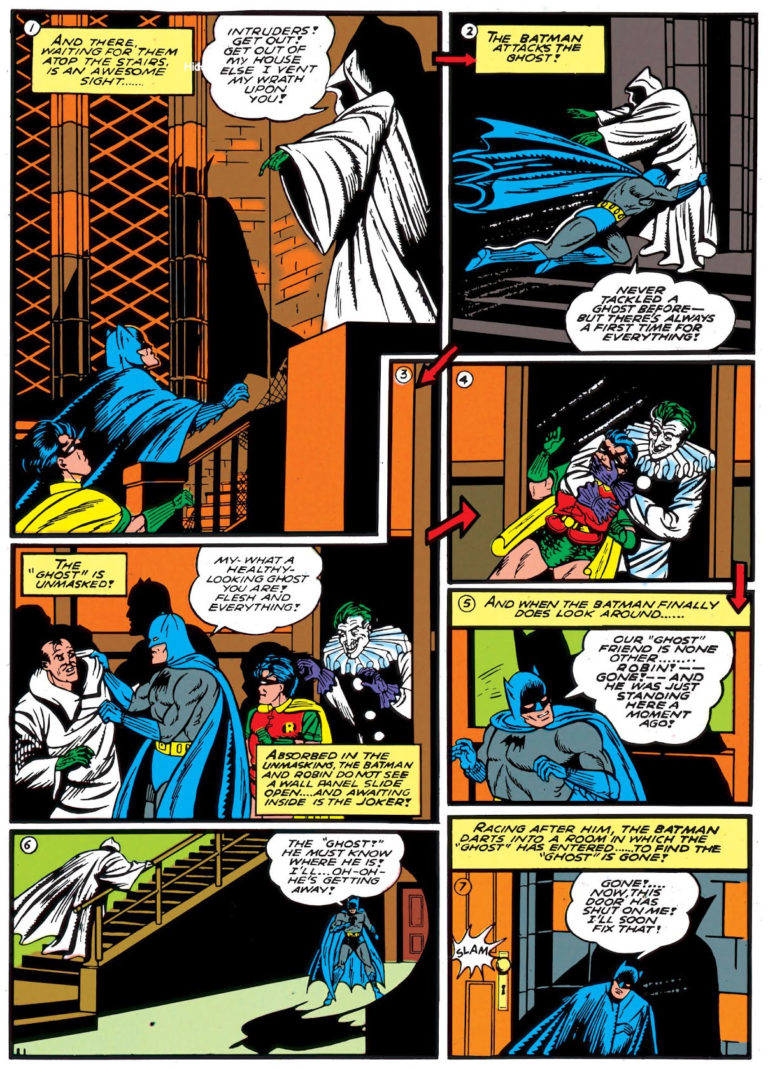
Batman fights his way through the haunted house, which includes giant laughing Joker-head illusions, and poisonous gas. At one point, he utilizes his utility belt to mix together two chemicals to make a powerful bomb to just cheat his way through the maze. When he finds Robin, Joker’s master plan is almost underway : throw Robin in some sewage. That’s it. Just chuck him down the ol’ mansion’s toilet hole. Instead, it’s Joker who gets kicked through the crapchute, and the story is over.
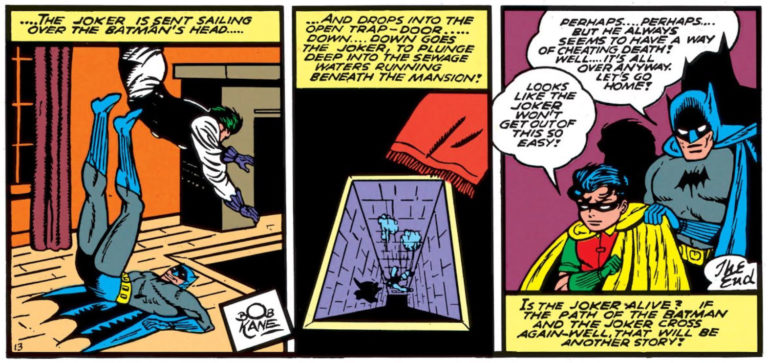
As far as Batman stories go, it’s almost a non-entity. Batman’s at his absolute lowest as a detective, letting crime run rampant while he puzzles over the world’s most poorly-disguised clown, starts fights in crowded areas, and gets his ass kicked. And then there’s the matter of Tino, a tiny, unassuming gangster who’s introduced as a special guest to the circus in one panel… and is never seen again.
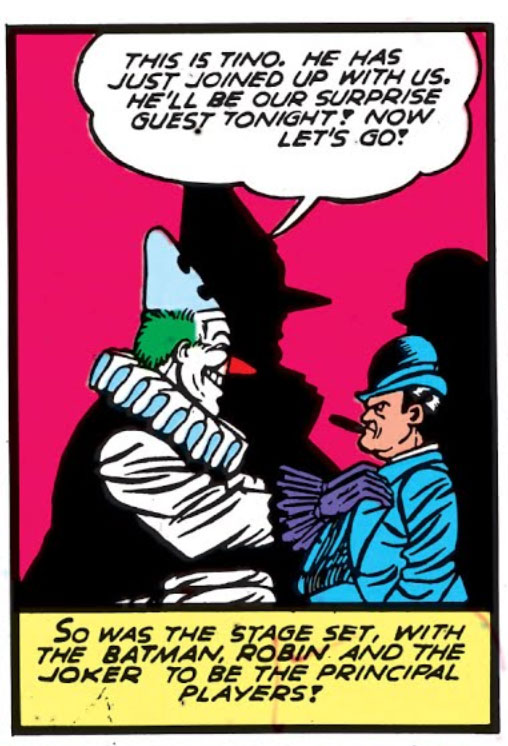
Maybe it was a weird bit of misdirection; we were meant to believe that Robin was in disguise as Tino? Probably not, because Robin comes crashing in three panels later. What are Tino’s circus powers? What’s the deal? The entire thread is lost, maybe for the best.
Next, Batman fights pirates!
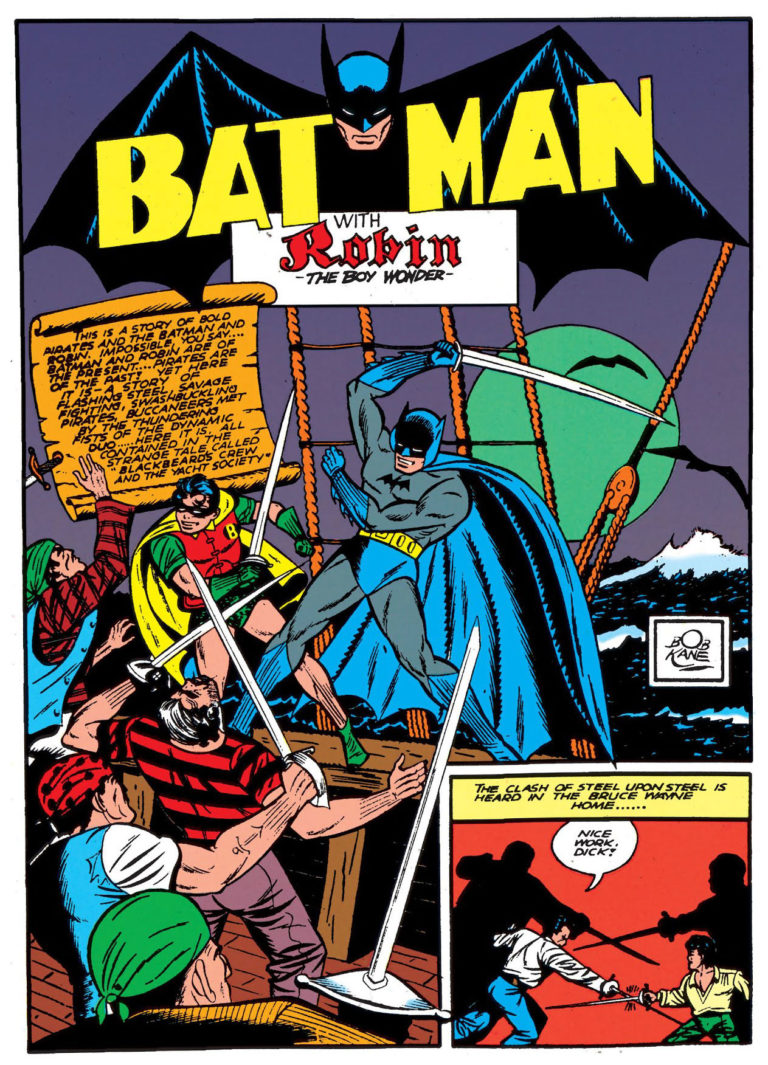
Bruce and Dick practice fencing, while nearby, a bunch of ill-fated people board a cruise ship : the mean, rich Mr. Horn and his secretary Stanley, the suicidal Mr. Cowden, and Elaine and her two jealous boyfriends. Why?
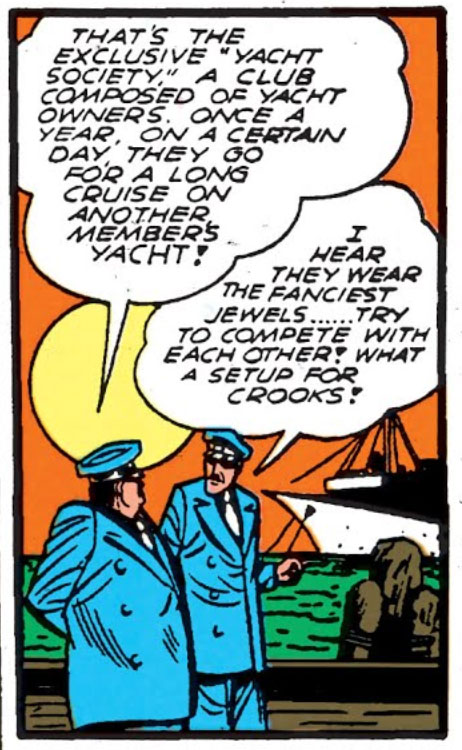
Well, that explains everything. More loudly-announced rich people crap that’s bound to be their undoing. As with every Batman comic so far, rich people are idiots in a constant, self-destructive pissing contest. While I wouldn’t say that Batman is anti-capitalist, the comic sure hates rich people, as much as Batman endeavors to save them.
After a few days on the boat, a black fog rolls in, along with a pirate ship. The yacht is boarded and taken over by a bunch of cosplayers, headed by a guy dressed up as Blackbeard. The goal? Steal all of the rich peoples’ jewels and ransom the captors off to their wealthy families. Fortunately, Batman intercepts a distress signal and shows up via Batplane, which transforms into a speedboat upon arrival.
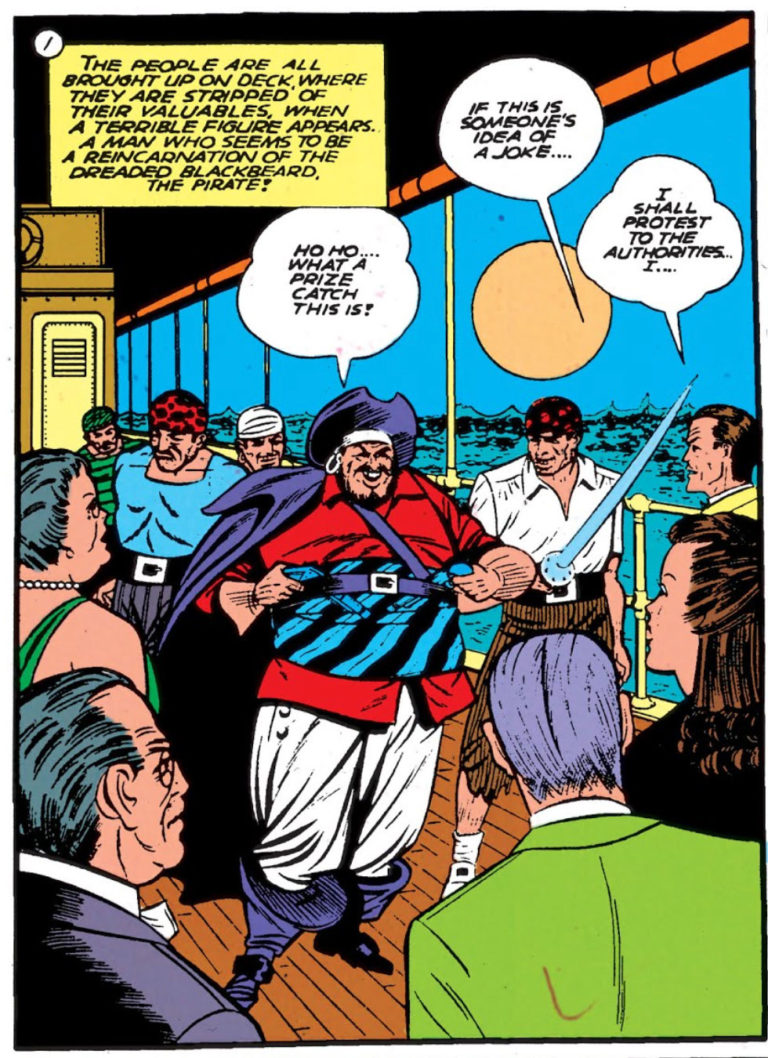
Batman slips quietly on board and takes out a few pirates alongside Robin before both are captured, and Robin is thrown overboard to some waiting sharks. This gives Batman an unholy burst of strength, and he dives overboard to gut the shark and save Robin before returning to the surface to fight again, sneaking into the quarters where the prisoners are being held. Not only was this shark absolutely eviscerated; Batman takes an absolutely vicious jab at Blackbeard by calling him “Mr. Dirty Beard”. Ouch.
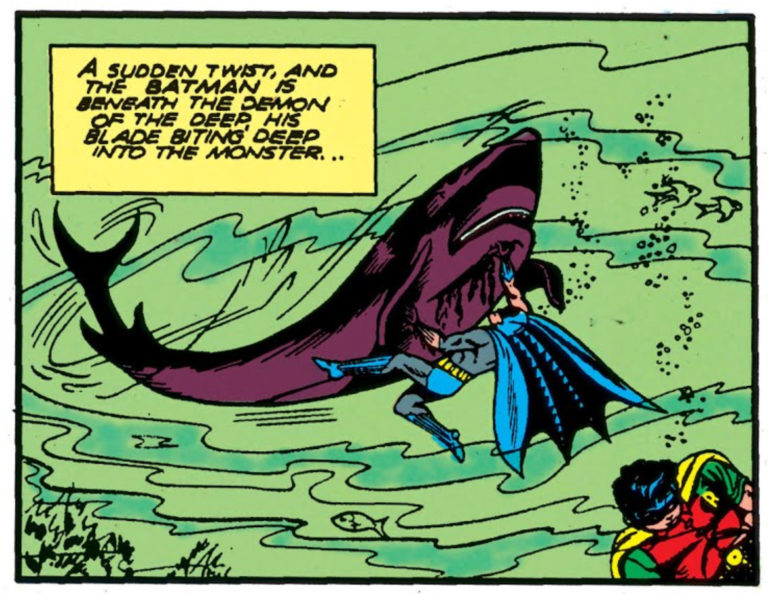
For the second time this issue, Batman endangers everyone around him by rallying the feeble civilian troops to gather arms from another part of the ship. It’s now that these very different people show their mettle; Mr. Cowden, already ready to die, joins the cause, as does Elaine’s less-favorite boyfriend, and the meek Stanley… the latter of whom Batman promptly rejects, saying that they have enough help already. Cold.
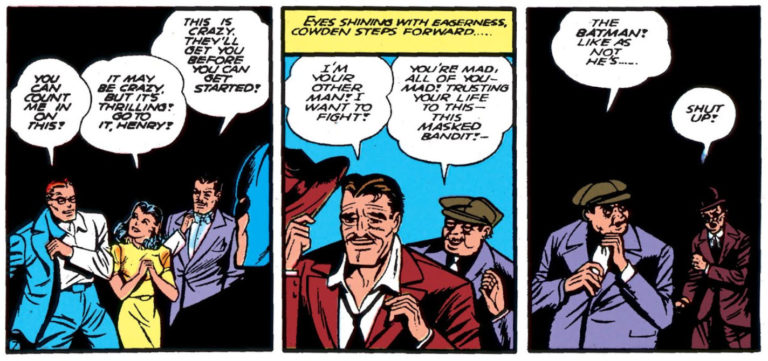
As another battle ensues, the dynamic duo’s fencing skills conveniently come into play. It at this moment that Batman, maybe for the first time, announces that he has a code against killing. Sure he’s murdered left and right until now, directly or indirectly, but this is the pivotal moment. Of course, the caveat is that he doesn’t kill with any weapons; whether or not throwing someone to their death counts towards this no-kill policy is uncertain. Either way, this is presumably the real turning point for Batman’s fighting style.
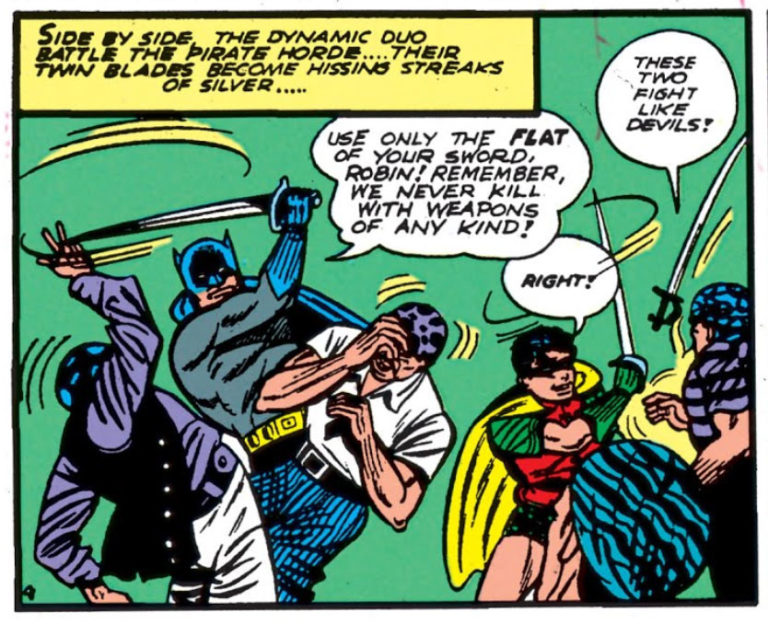
The pirates are bloodlessly dispatched and trapped under a fallen boat sail when Blackbeard reappears, and Batman lets loose with one of his legendary quips.
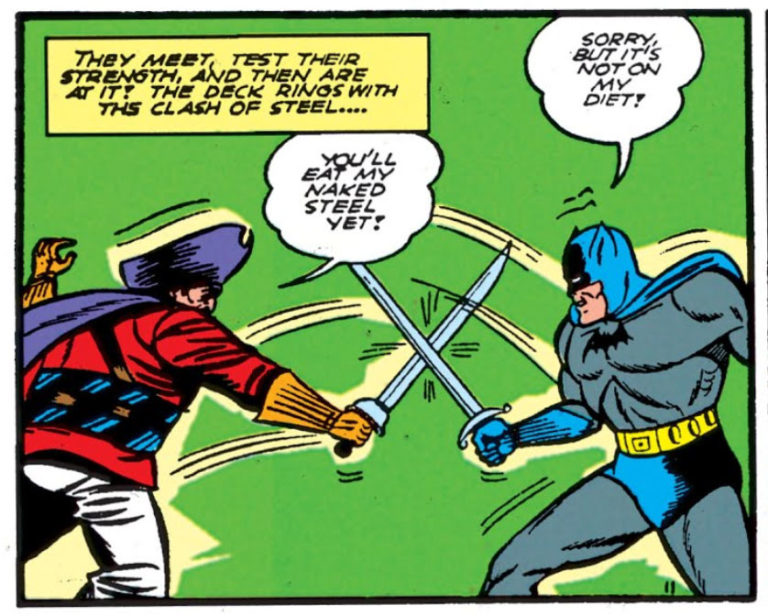
Batman wins, and Blackbeard’s true identity is revealed: he’s some never-before-mentioned gangster named Thatch. Batman knew it all along, though, because the real Blackbeard’s last name was Thatch, too. And also, Thatch used to be an actor. And also, for good measure, if Blackbeard and his crew had really just appeared suddenly via time travel… they wouldn’t know who Batman was. The logic gets a bit lost; either Batman is saying that the pirate crew knew him as Batman because they’re criminals (even though Batman was a known figure to everyone), or because they were actual modern-day people all along, of which there was never any doubt. No one actually suspected that this was a pirate who sailed right out of the 1700s, so flexing his rarely-used Powers of Understanding Reality, Batman is really strutting his stuff here. Unfortunately, for a mystery story, the reader is completely left out of solving it for themselves; not a single clue is dropped. This is an mystery that plays out entirely inside of Batman’s head.
The lives of the kidnapped yacht people are changed forever; after they use the captured firearms to round up the defeated pirates, Elaine chooses the boyfriend who was more courageous, the suicidal guy decides life is worth living, and Stanley’s willingness to fight is rewarded by his employer. The end. And the, we get a bizarre cautionary tale….
This is the story of Jimmy McCoy, and his rise to criminal power, all because he wanted to support his widowed mother by delivering bootleg booze at the tender age of 17. Jimmy is caught, because he’s an amateur criminal delivery boy at best, but the stress of his impending incarceration kills his mother right in the courtroom, hardening Jimmy into a determined ne’er-do-well. He returns to prison over and over, learning the ropes from more experienced criminals. Through nothing but sheer grit, he takes over the New York underworld in a matter of years – but is sent back to prison for tax evasion.
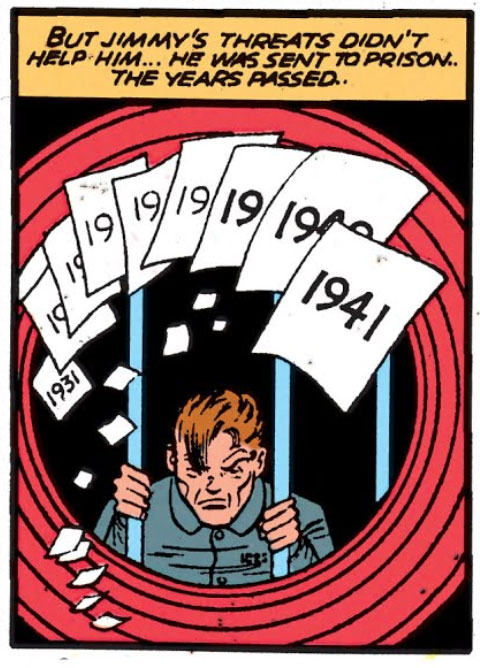
At this point, we’re like three pages in and there’s no sign of Batman. This is a Breaking Bad-style slice of life tale about a guy who’s going to die by the end of the story. But it also seems to express a lot of dissatisfaction with a number of societal structures; the difficulty in finding an honest job that pays a living wage, the broken prison system, and the temptations to turn to criminal behavior just to survive. Eventually, Jimmy just gets addicted to power, or just so deeply entrenched in the criminal world that he can’t get out, but he seems to be having a good time.
Eventually, Jimmy pisses off a competing gangster named Costello, and he becomes the target of a drive-by; a stray bullet hits a small girl in the leg. Which is pretty rough stuff.
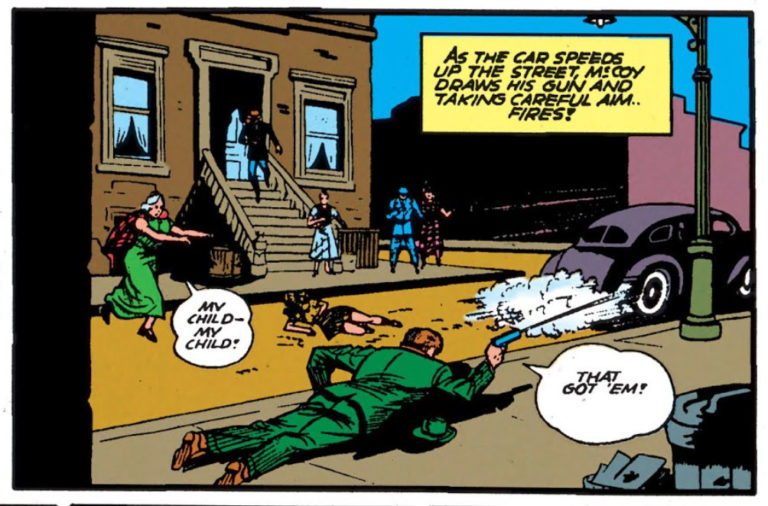
Batman finally shows up and pursues McCoy, but has to stop when McCoy lands a bullet in Batman’s shoulder. As McCoy is gathering up a new gang, we learn that he carries around a rabbit’s foot, and refuses to light more than two cigars with the same match. While the latter seems like a weird and forgotten superstition, it was fresh in the mind of writers in the 1940s. A 1932 film called The Match King explored the origins of the superstition; that same year, Three on a Match explored the same idea. It’s popped up a few times in popular media since, but the popularity of the superstition in the ’30s is undeniable.
After weeks of a violent gang war raging through the streets of New York (not Gotham, as the papers reporting the news all read New York still), Bruce Wayne finally decides to send out Robin on a recon mission. Disguised as a shoeshine boy, Robin slips into McCoy’s hideout and discovers that they’re going to show up at the Penguin Club. No, a different Penguin Club; the actual Penguin wouldn’t show up in DC Comics for another year.
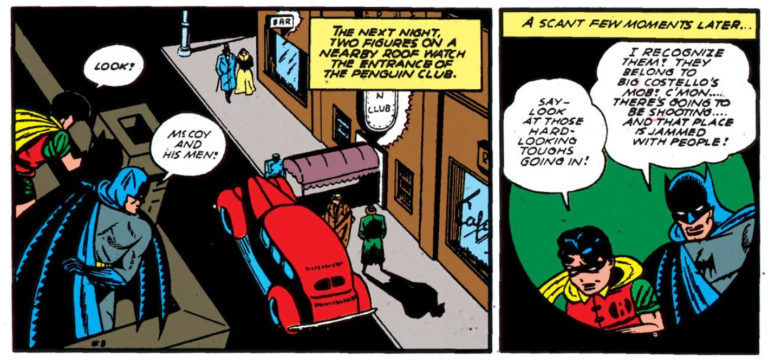
Despite having 24 hours notice, Batman and Robin show up just too late to stop the fracas. The crooks fight with guns; Batman starts a food fight. The criminals disperse, and McCoy, shot in the shoulder, stumbles out into the rainy night.
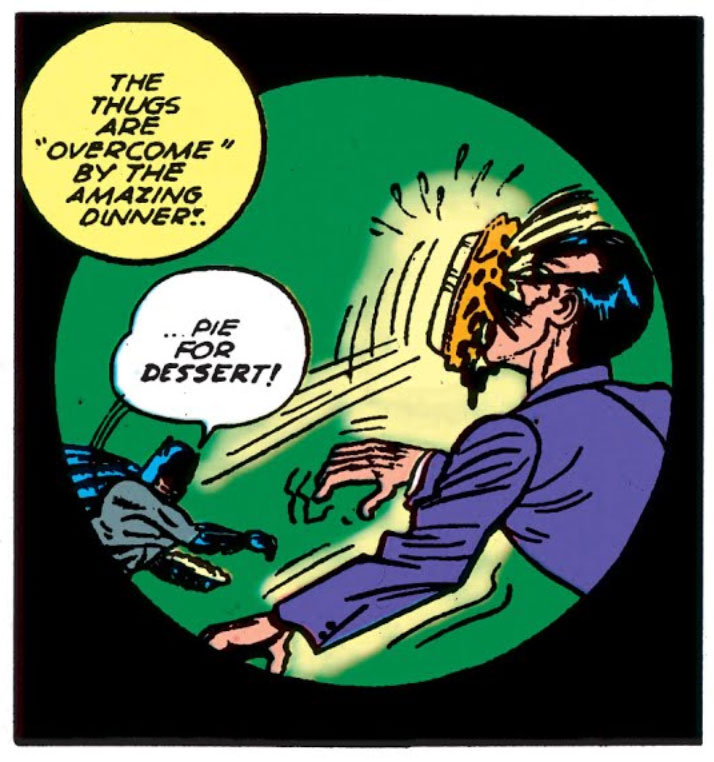
Except, oh no! He dropped his rabbit’s foot! And also he sees a black cat! And oh crap, it’s also Friday the 13th! And dammit, he just walked under a ladder! Okay, not that last one, but it’s the trifecta of meaningless symbols! Criminals are superstitious!

The criminal battling reconvenes in the rain, and McCoy is shot… but not before taking out all of the bad guys with his own gun. Batman shows up, but McCoy is already dead. Like the rest of this story, Batman is only a supporting character that shows up, has little effect, and disappears.
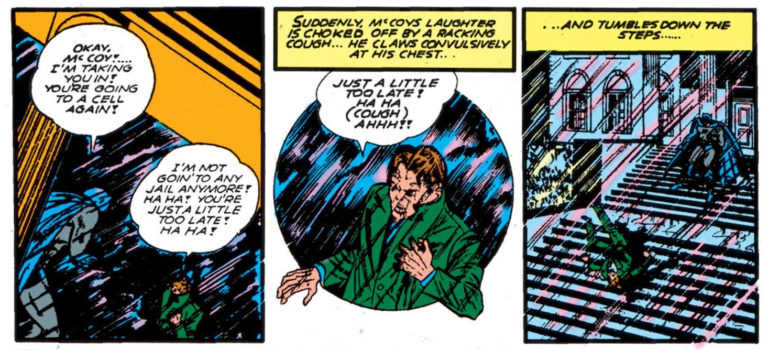
Because this is framed as some kind of literary feat of moral proselytizing, it ends with a moral…. which is don’t do crime. Sure, criminals are rich and have nice clothes and exciting lives, but that incredibly fun life will be short. Or at least that’s what Batman seems to be saying. None of this makes crime seem that terrible, and McCoy’s journey starts with the absolute best of intentions. What’s the real lesson here?
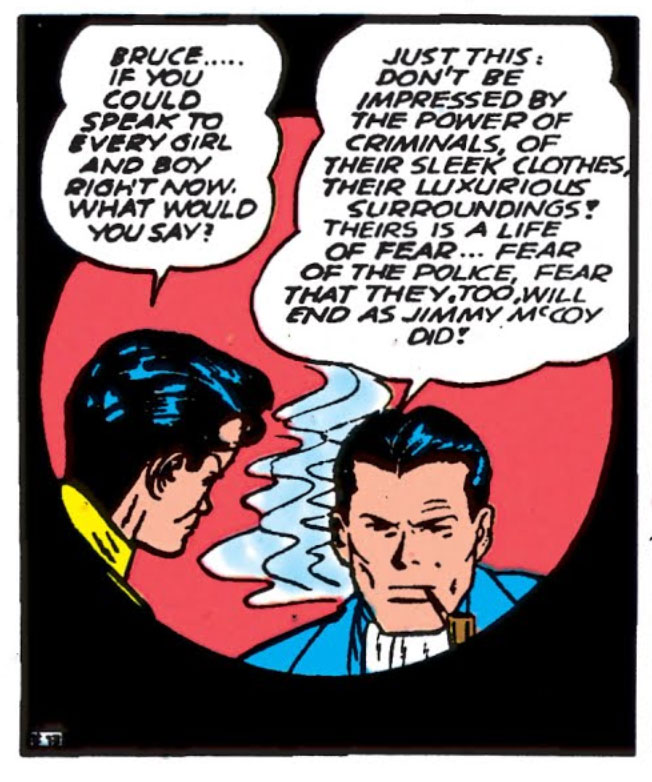
The lesson is that early Batman stories were so far up their own butt that this whole issue barely makes any sense. And then…
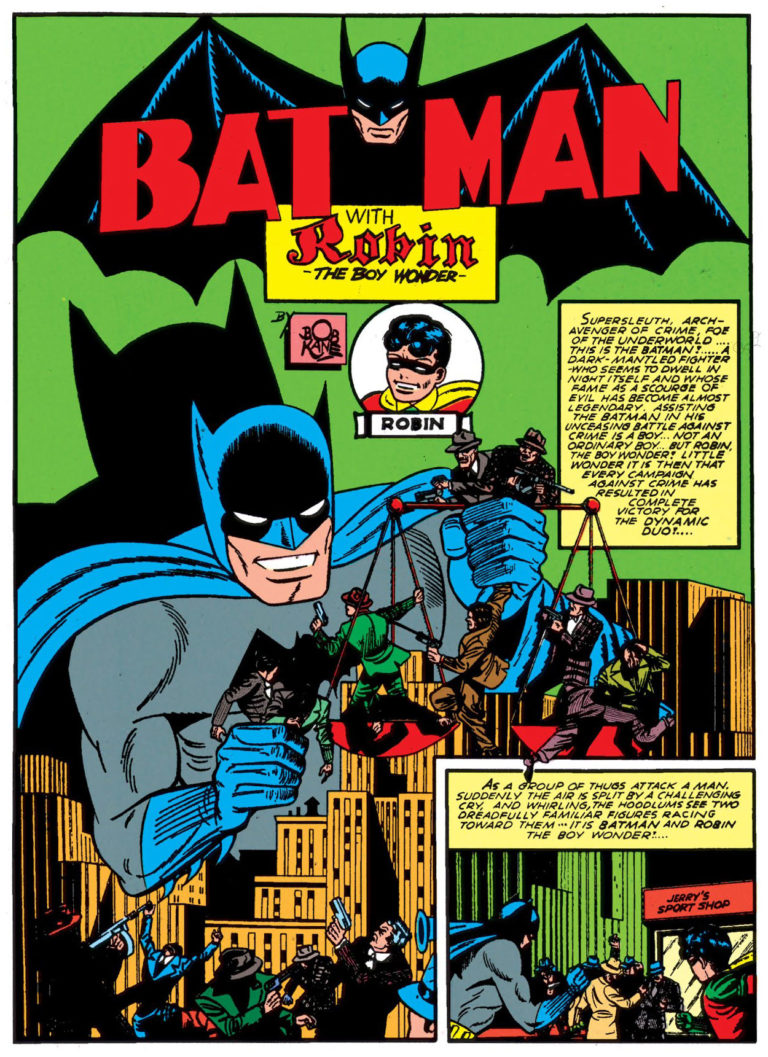
Batman and Robin happen to see a gunfight break out outside of Jerry’s Sport Shop, which is punctuated by the second machine-gun drive-by this issue. Batman survives and retaliates with a gun he picks up… but the editors are very careful to let the reader know that Batman doesn’t actually carry a gun or kill people with guns. He just uses guns he finds to cripple people. Which I guess is better.
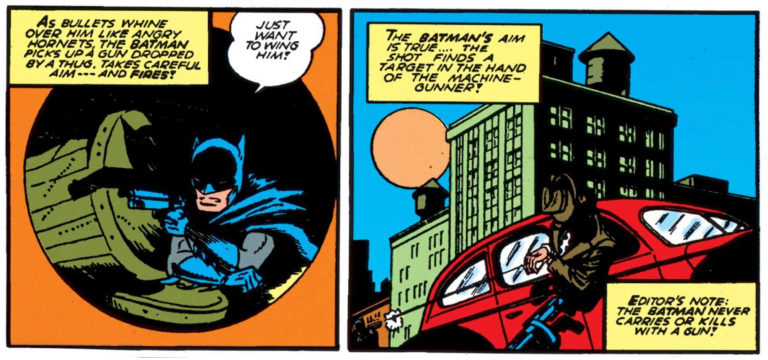
Turns out the target is Tim Bannon, coach of the Panthers, a professional football team. The Carolina Panthers wouldn’t be founded until 1991, but Batman saw it coming. Turns out that the Panthers are playing the Lions in a few days (the Detroit Lions WERE a thing in 1940), and the crooked owner of the Lions, ‘Stacy the Gambler’, is trying to mess up the odds in his favor by just killing people. Stacy doesn’t like Batman meddling in his murder plots, but he has a weapon against batman that no one else has used before: he knows who Batman really is, and so do his henchmen.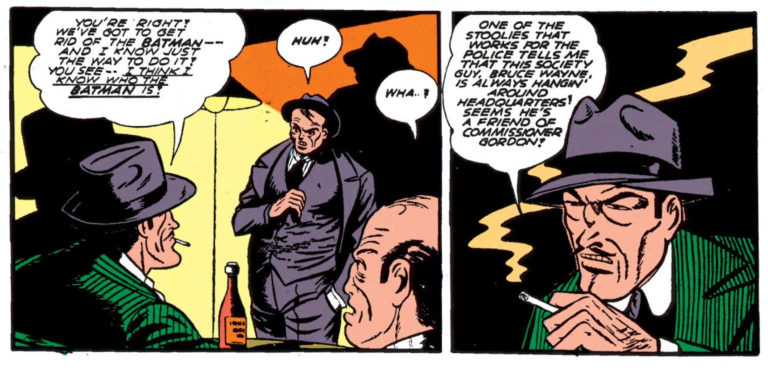
Bruce Wayne gets a prank call from Stacy, pretending to be someone in danger who also happens to know that Bruce = Bats. Instead of playing dumb, or figuring out that it’s a trap, Batman shows up to his caller’s address right on time, pretty much confirming that yes, Bruce Wayne is Batman. Genius move. They all get into a fight, and Batman and Robin retreat to a cabin near Wayne Manor, with the gangsters in tow. Fortunately for Stacy, he had men stationed outside of the Manor, so Bruce could have never made it inside. Or could he?
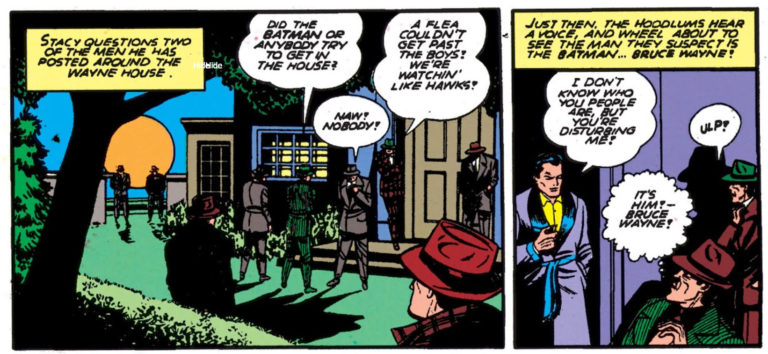
While the criminals watch Bruce Wayne idly read a book inside, Batman appears outside to kick their asses. But how did he get inside to being with? Despite the fact that everyone was watching, he… just got in. Secret Bat-tunnels.
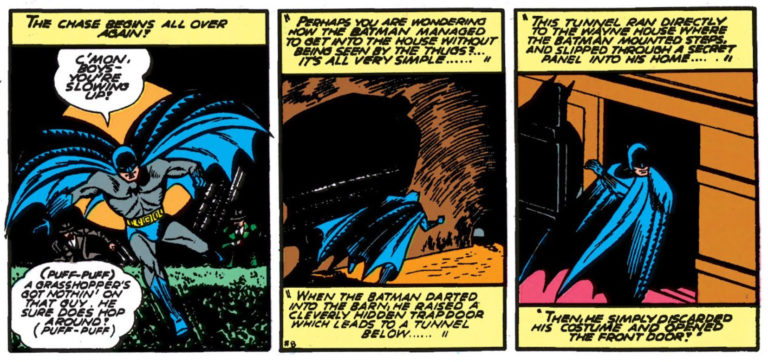
But wait, it gets weirder. How was Bruce Wayne also inside, reading? Because Robin was wearing a full-sized Bruce Wayne costume that he just happened to have around because that’s not at all creepy.
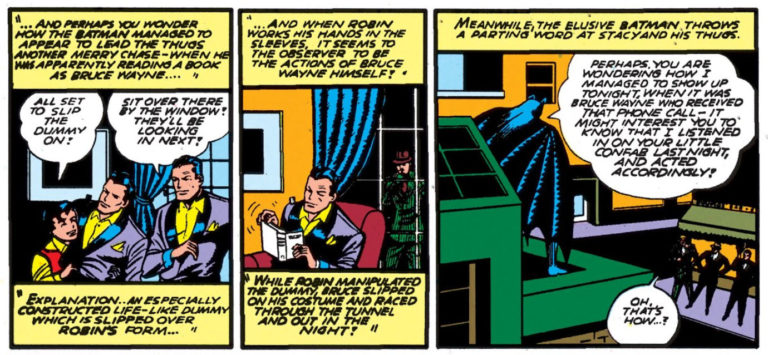
Even though Batman doth protest way, way, way too much, and successfully turned this into a wholly overcomplicated situation, he’s cleared his name. Stacy is convinced that Bruce Wayne is just a dumb rich idiot, and proceeds with his plans; he kidnaps a star player named Stockton. Batman finds out, and his Bat-plans become even more insane : he pulls a full-on Clayface and disguises himself as Stockton, using makeup and putty from his utility belt, before going out and playing in the big game.
Obviously, Stacy is confused, leaves the stadium, and Robin follows him to his hideout, where he beats up some thugs.
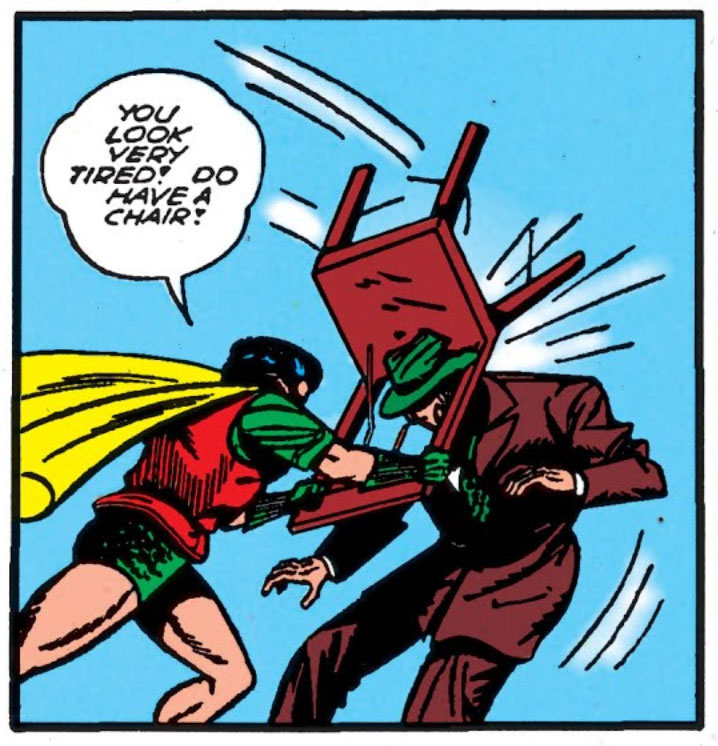
Stockton is freed, but who cares? It turns out that Batman is the ultimate football god. He can do no wrong, and plays even better than Stockton.
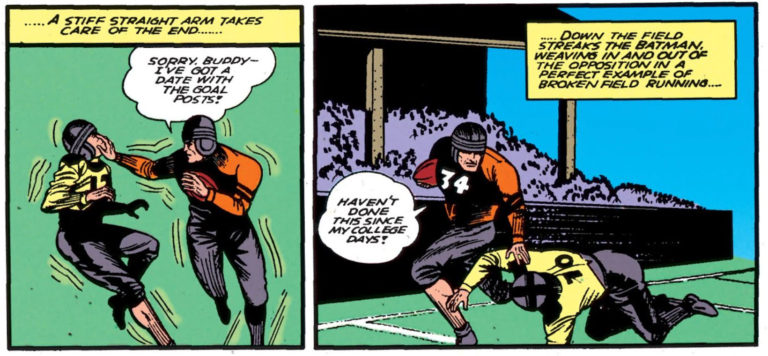
Stockton gets there and the two switch places. Because Bruce Wayne is still in disguise as Stockton, the real football player is none the wiser about Batman’s true identity. Bruce and Dick stick around to watch the end of the game, and all is well. More or less.
There’s a smattering of people out there who are suspicious that Bruce Wayne is Batman for no other reason than Wayne very conspicuously hangs out at the police station for no discernable reason. Either he’s Commissioner Gordon’s special friend, or he’s Batman – there’s no other way. Batman, stop being such a dingus! You’re a mess.
Overall, Batman #4 is a mix of stories that are so bizarrely straightforward that they barely have a plot, and one final story that’s so overwrought with costumes and twists that it’s absolutely unbelievable. While Batman is finding himself, turning down gun violence and murder for the first time, he’s still making amazingly incompetent errors. He loses fights with street-level thugs constantly, but he’s still a football wizard. He has gadgets that can blow up walls and disguise him completely, but his conspicuousness is his undoing.
Meanwhile, over in Detective Comics, where Batman still has concurrent adventures, we’re around issue #46. At this point, Batman has faced Basil Karlo’s Clayface, a giant named Gorl from the 4th Dimension, and The Painter of Death. Detective Comics Batman is definitely having more fun. Will this Batman stop being such a dunce by Batman #5? Stay tuned to find out.
All comic images are copyright DC Comics and presented here for the purposes of criticism & commentary.
 C. David is a writer and artist living in the Hudson Valley, NY. He loves pinball, Wazmo Nariz, Rem Lezar, MODOK, pogs, Ultra Monsters, 80s horror, and is secretly very enthusiastic about everything else not listed here.
C. David is a writer and artist living in the Hudson Valley, NY. He loves pinball, Wazmo Nariz, Rem Lezar, MODOK, pogs, Ultra Monsters, 80s horror, and is secretly very enthusiastic about everything else not listed here.
